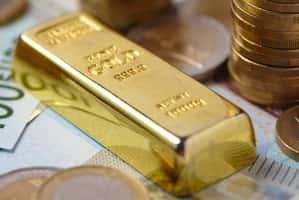Throughout human history, gold and silver have functioned as money due to their rareness and unique properties. Precious metals are a proven medium of exchange, portable, divisible, interchangeable, durable, and valued across the world. It’s remarkable that human civilizations of different eras, cultures, and geographies – all valued gold and silver, even though they had wildly different beliefs and ways of life. It almost seems as if the value of these assets is wired into our DNA.
Until 1971, all major currencies were backed by gold reserves, however, this changed under the Bretton-Woods agreement which severed the link between fiat currencies and gold. Now, gold and silver are less seen as money and more viewed as an investment option to protect purchasing power and tend to outperform during periods of high inflation and weak economic growth. Besides investment demand, there is also industrial demand for gold and silver due to their antimicrobial properties and ability to conduct electricity.
While many investors choose to invest in precious metals through ETFs, coins, or bullion, another option is to invest in gold and silver mining stocks. During bull markets, miners are the best performing group in the precious metals complex as any gains in the price flow straight to the bottom line. Of course, the key is to find miners with low costs and increasing production. 5 gold and silver miners with these characteristics are Alamos Gold (AGI), AngloGold Ashanti (AU), Yamana Gold (AUY), Gold Fields Limited (GFI), and B2Gold Corp. (BTG).
Gold and Silver Demand
Gold
Like most industries, the coronavirus dented demand for gold. In 2020, the total demand for gold was 3,759 tons which was a 14% decrease from 2019. It also marked the first year that demand fell under 4,000 tons since 2009.
Gold has four major sources of demand – investment; jewelry; central banks; and technology and industrial applications. Investment demand makes up the largest share at 46.7%. Notably, this demand strengthened in 2020 due to the Federal Reserve slashing rates, investors seeking safety, and concerns that fiscal and monetary stimulus would ignite inflation. As a result, demand for gold bars and coins increased by 10%, while gold ETFs, on a global basis, increased their holdings by 877 tons.
Due to the coronavirus, it’s not surprising that jewelry demand declined by 13% to 515.6 tons last year as spending on these discretionary purchases contracted. However, jewelry demand should be higher than average in the next couple of years due to pent-up demand from this year’s drop in consumption. In total, jewelry accounts for about 39% of gold demand.
Many central banks hold gold as part of their reserves which they keep diversified through various assets and currencies. In normal years, central bank buying accounts for about 9% of gold demand. In 2020, central banks bought 279 tons which was a 59% drop from 2019. In general, central banks were preoccupied with ensuring that liquidity was abundant to decrease systemic risk and to keep the banking system functioning. Thus, central banks were net sellers of gold in the first half of 2020.
The final major component of gold demand comes from the technology industry. Gold is used in a variety of technology devices since it is resistant to rust and corrosion which makes it a great electric conductor and used in electronics and satellite communications. This accounts for about 8% of gold demand. In 2020, this source of gold demand dropped by 7%, largely due to a severe drop in Q2 due to the lockdowns. However, trends are positive as there has been a significant improvement on a quarter to quarter basis.
Silver
Silver has a much higher share of industrial demand. On average, 55% of silver demand is for industrial use due to its conductivity, malleability, and sensitivity to light. It’s used in areas that are growing rapidly such as solar panels, LEDs, screens, and semiconductors. Industrial demand for silver is forecast to increase 9% in 2021 primarily due to the strong global economic rebound.
26% of demand comes from jewelry and silverware. This segment should also do well in the coming years as it tangentially benefits from the economy reopening and subsequent release of pent-up demand over the last year.
Another 21% is due to investment demand which includes ETFs, coins, and bullion. This segment saw a sharp spike in 2020 due to investors concerned about the economy and the effects of the government’s stimulus spending. Silver is considered to be a hedge against inflation. If this trend continues, then it’s likely to see continued inflows.
Gold and Silver Supply
The two sources of gold are mining and recycling. In 2020, 4,400 tons of gold were produced in total. This was a dropoff from 4,800 tons in 2019 largely due to coronavirus disruptions. On average, mining accounts for 73% of gold supply and recycling the other 27%. However, more gold is recycled when the price moves higher.
72% of silver production is from mining projects, where it is a byproduct of mining other metals such as copper, lead, and zinc. Silver deposits are found all over the world but about 57% of accessible ones are in South and North America. In 2020, 976 million ounces of silver were produced from a combination of mining and recycling. Mining accounted for 82% and recycling for 18%.
Relationship to Real Interest Rates
Changes in industrial demand are relatively muted, although it tends to trend higher but experience some swings along with the economy. In the short-term, investment demand is the largest source of price moves in gold and silver.
Therefore, it’s not unusual to see large moves in the metals when important economic data comes out regarding inflation, employment, and growth. Investment demand for gold tends to track real interest rates which is the difference between short-term rates and the inflation rate.
When real interest rates are high or moving higher, investment demand for gold declines as investors can earn a positive return by keeping money in short-term Treasuries. However, demand increases when real interest rates decline or go negative as then gold’s zero rate of return becomes marginally more attractive.
Therefore, precious metals investment demand sees the largest rise during periods of slowing economic growth and rising inflation. Slowing growth makes it more likely that interest rates will decline and stay lower for a longer time, while inflation increases the appeal of hard assets over fiat-based ones.
5 Miners
As noted above, gold and silver miners are one of the best vehicles to gain exposure to the bull market in precious metals. The ones discussed below are trading at attractive valuations and have costs of production that are significantly lower than today’s prices. This means that further gains in the gold price will flow directly to the bottom line.
Gold and silver prices declined, along with most other assets, during the coronavirus crash in March of 2020. However, gold and silver prices rebounded with fervor, as the Fed and federal government stepped up with major stimulus, and went on to make new highs in a matter of months.
Over the last couple of months, inflation concerns have increased and gold and silver have recovered nicely. Many investors believe that this is the start of a significant bull market for gold and silver, with some experts predicting the yellow metal could reach as high as $5,000 – $10,000, and silver reaching $40.
If you believe that a gold and silver bull market is expected, then you should consider buying these 5 miners:
Alamos Gold (AGI)
AGI is a Canadian-based miner with operations in Mexico, Canada, Turkey, and the US. In the first quarter, the company produced 125,800 ounces of gold, a 14% increase from last year and above expectations. This resulted in record revenues of $227.4 million during the quarter with sales of 126,482 ounces of gold at an average realized price of $1,798 per ounce. EPS was $0.13, a 67% increase from last year.
The company is in the midst of a Phase III expansion at its Island Gold mine to increase exploration efforts and construction of the higher grade La Yaqui Grande project. Both should begin commercial production by Q3 of next year.
Currently, the company’s reserves totaled 9.9 million ounces. It forecasts gold production between 470,000 oz and 510,000 oz for the full year. Most importantly, the company’s all-in cost of production is around $1,030 per ounce which gives it tremendous margins.
According to the POWR Ratings, AGI has an overall B rating, which equates to a Buy in our proprietary rating system. B-rated stocks have posted an average annual performance of 19.7% since inception. AGI also has a B grade for Growth which isn’t surprising given its increasing production and rising gold price.
Beyond what we stated above, we also have given AGI grades for Momentum, Quality. Industry. Value, Stability, and Sentiment. Get all AGI’s ratings here.
AngloGold Ashanti (AU)
AU derives the bulk of its revenues from gold but also produces silver and uranium. It currently has 10 production sites and 3 exploration projects across 8 countries.
The company delivered EPS of $0.48 in the first quarter which was above expectations and an improvement from last year’s $0.34 per share. The company was also able to use its free cash flow to continue retiring debt which declined from $1.6 billion at the start of 2020 to $900 million in the latest quarter.
The company’s primary focus is on increasing production and adding reserves. Total production in Q1 was 588,000 ounces at $999 per ounce. This was lower than last year’s production of 630,000 ounces at a cost of $773 per ounce. This was largely due to the company’s exploration efforts and the coronavirus with many mines’ operations shuttered or limited.
If gold prices can remain at current levels or even keep moving higher, then AU will be a great buy. Currently, it has a very low price to earnings (PE) ratio of 9.9 which is significantly cheaper than the S&P 500. The company should be able to continue growing based on its forecast of adding new production as well.
Due to these positive developments, AU has an overall grade of B, which translates to a Buy rating in our POWR Rating system. It also has a B for Value which is not surprising given its very low valuation relative to its peers and the broader market. To see AU’s other component grades including Growth, Momentum, Sentiment, Stability, Quality, and Industry, please click here.
Yamana Gold (AUY)
AUY is a Canadian miner of gold and silver with several projects in production, development, and exploration in South and North America. The company recently completed a deal with Monarch Gold Corporation to add reserves in Quebec which should lead to a 10 to 15% increase in production over the next couple of years.
In its last quarter, AUY reported EPS of $0.06 per share, an improvement from last year’s $0.05 per share. Total cash flow was $160 million, a 30% increase from last year. The company produced 231,000 gold equivalent ounces and 2.13 million ounces of silver. The cost of production was $1,045 per ounce which indicates strong profit potential in a gold bull market.
This leverage to gold’s price makes AUY particularly attractive especially as long-term rates have declined, while inflation concerns are building. Thus, it’s not surprising that AUY has an overall rating of B, which equates to a Buy in the POWR Ratings.
Gold Fields Limited (GFI)
GFI is a producer of gold and copper, involved in underground and surface gold and copper mining, exploration, development, extraction, processing, and smelting. It holds interests in nine operating mines located in Australia, Peru, South Africa, and West Africa. GFI has 56.1 million ounces of gold equivalent reserves.
Most of GFI’s gold comes from Australia and West Africa. Like many miners, it was impacted by the coronavirus which led to lower production levels, although it was offset somewhat by higher prices. However, as of GFI’s latest report, its mines are back to running at full capacity.
In its last quarter, revenue increased 31.2% to $3.89 billion. Its attributable gold equivalent production for 2020 was 2.236 million ounces, up 2% year-over-year, while its all-in costs were marginally higher from the prior year to $1,079 per oz. Overall, GFI remains reasonably priced with a forward PE of 11 and 31% earnings growth.
GFI’s strong fundamentals are reflected in its POWR Ratings. The stock has an overall B rating, which equates to a Buy. Further, it has a B for Value which isn’t surprising given its combination of low multiples and healthy cash reserves in addition to being cash flow positive.
If you are interested in GFI’s component grades for Growth, Momentum, Industry, Stability, Quality, and Sentiment, please click here.
B2Gold Corp (BTG)
BTG has operations in Mali, the Philippines, and Namibia with reserves and development projects in a variety of additional locations. It’s known as one of the producers with the lowest costs due to easily accessible reserves in certain locations.
BTG shares spiked higher following its Q1 results as the company topped expectations for a variety of metrics. It produced 220,664 ounces of gold in Q1, 9% above its forecast. The company earned $362 million in net income. It also announced positive drilling results at its Fekola mill with reserves being higher-quality than expected.
In 2021, the company is forecasting production of 1.04 million ounces which would translate into earnings growth of 16% compared to 2020. BTG certainly has major upside given that it has a PE of 8.6 and very low costs of production compared to its peers.
Given its strong earnings report and advantageous position, it’s not surprising that BTG has an overall B rating, which equates to a Buy in our POWR Ratings system. The company also has an A for Quality which is consistent with its position as one of the low-cost producers and ownership of high-quality assets. Click here to see more information on BTG.
Discover Today’s Best Growth Stocks
This article was written by Jaimini Desai, Chief Growth Strategist for StockNews.com. Jaimini has been dialed into the hottest trends in investing:
- Electric Vehicles
- 5G
- Internet of Things
- Cloud Computing
- Genomics
- And Much More
If you would like to see more of his best growth stock ideas, then click the link below.
See Jaimini Desai’s Favorite Growth Stocks
Want More Great Investing Ideas?
AUY shares were trading at $5.23 per share on Friday afternoon, up $0.06 (+1.16%). Year-to-date, AUY has declined -8.41%, versus a 12.89% rise in the benchmark S&P 500 index during the same period.
About the Author: Jaimini Desai

Jaimini Desai has been a financial writer and reporter for nearly a decade. His goal is to help readers identify risks and opportunities in the markets. He is the Chief Growth Strategist for StockNews.com and the editor of the POWR Growth and POWR Stocks Under $10 newsletters. Learn more about Jaimini’s background, along with links to his most recent articles. More...
More Resources for the Stocks in this Article
| Ticker | POWR Rating | Industry Rank | Rank in Industry |
| AUY | Get Rating | Get Rating | Get Rating |
| AGI | Get Rating | Get Rating | Get Rating |
| GLD | Get Rating | Get Rating | Get Rating |
| BTG | Get Rating | Get Rating | Get Rating |
| AU | Get Rating | Get Rating | Get Rating |
| GFI | Get Rating | Get Rating | Get Rating |





